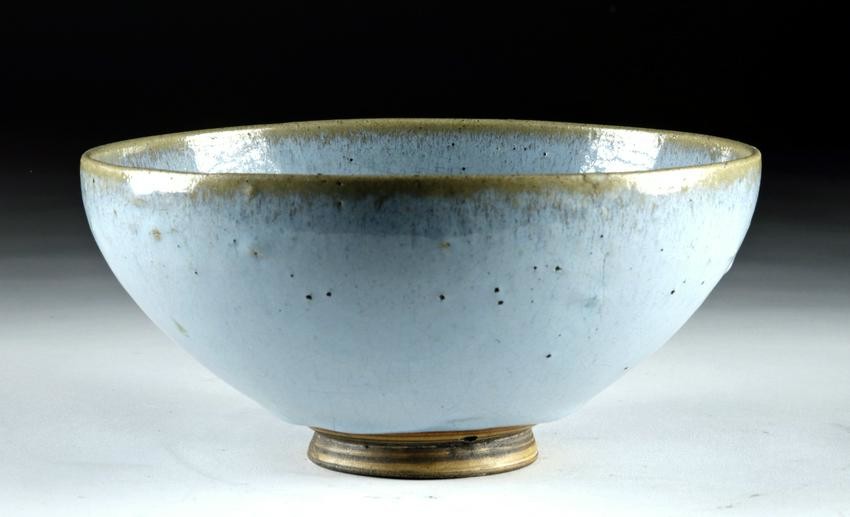Chinese Song Dynasty Longquan Celadon Bowl, TL Tested
**Holiday Shipping Deadlines**
USA Domestic: 12/14 for Standard; 12/23 for Express
International: 12/7 for Standard; 12/19 for Express
East Asia, China, Longquan, Song Dynasty, ca. 1127 to 1279 CE. A striking, sizeable bowl with a lovely sky blue glaze over its smooth surface, produced by Chinese Imperial state-owned and operated kilns. The foot is adorned with a brown linear pattern resembling the rings of a tree trunk. Glaze has descended from the top rim producing a pleasing feathery pattern and a grey strip around the rim. The rest of the piece is covered with a stunning azure blue color embellished with some crackling. Longquan celadon ceramics are known for their varying shades of either olive green, blue green, or blue as we see in this example. Size: 8.25" W x 4" H (21 cm x 10.2 cm)
Bowls like this were some of China's most important exports during the Song period, and were widely imitated in Korea and Japan. The body was thrown on a potter's wheel and the color of the glaze that covers all but its foot comes from iron oxides fired in a reducing atmosphere. These objects were fired in "dragon kilns", long brick tunnels that rose up a slope, to provide slow and even heating. Archaeologists estimate that up to 25,000 vessels would be made at once in the largest of these kilns! The market for bowls like these were the scholar-gentleman class, sometimes known as the literati; these were made for everyday use, religious ceremonies (placing offerings on altars, for example), and sometimes were buried with their owners. Their beauty spawned legends; for example, the few that made their way to Europe were sometimes turned into goblets with the aid of metal components because of a belief that their glaze would change color in the presence of poison.
This piece has been tested using thermoluminescence (TL) analysis and has been found to be ancient and of the period stated. A full report will accompany purchase.
Provenance: private East Coast, USA collection; ex-Artemis Gallery; ex-Paul and Louise Bernheimer, Cambridge, Massachusetts, USA, and Laguna Woods, California, USA, acquired before 1980
All items legal to buy/sell under U.S. Statute covering cultural patrimony Code 2600, CHAPTER 14, and are guaranteed to be as described or your money back.
A Certificate of Authenticity will accompany all winning bids.
We ship worldwide to most countries and handle all shipping in-house for your convenience.
#142817
Condition Report: Tiny fissure and chip on the rim filled in with clear plastic. This is well done and almost impossible to see. Small chip from base of foot. Beautiful craquelure on surface.
View it on
Estimate
Time, Location
Auction House
**Holiday Shipping Deadlines**
USA Domestic: 12/14 for Standard; 12/23 for Express
International: 12/7 for Standard; 12/19 for Express
East Asia, China, Longquan, Song Dynasty, ca. 1127 to 1279 CE. A striking, sizeable bowl with a lovely sky blue glaze over its smooth surface, produced by Chinese Imperial state-owned and operated kilns. The foot is adorned with a brown linear pattern resembling the rings of a tree trunk. Glaze has descended from the top rim producing a pleasing feathery pattern and a grey strip around the rim. The rest of the piece is covered with a stunning azure blue color embellished with some crackling. Longquan celadon ceramics are known for their varying shades of either olive green, blue green, or blue as we see in this example. Size: 8.25" W x 4" H (21 cm x 10.2 cm)
Bowls like this were some of China's most important exports during the Song period, and were widely imitated in Korea and Japan. The body was thrown on a potter's wheel and the color of the glaze that covers all but its foot comes from iron oxides fired in a reducing atmosphere. These objects were fired in "dragon kilns", long brick tunnels that rose up a slope, to provide slow and even heating. Archaeologists estimate that up to 25,000 vessels would be made at once in the largest of these kilns! The market for bowls like these were the scholar-gentleman class, sometimes known as the literati; these were made for everyday use, religious ceremonies (placing offerings on altars, for example), and sometimes were buried with their owners. Their beauty spawned legends; for example, the few that made their way to Europe were sometimes turned into goblets with the aid of metal components because of a belief that their glaze would change color in the presence of poison.
This piece has been tested using thermoluminescence (TL) analysis and has been found to be ancient and of the period stated. A full report will accompany purchase.
Provenance: private East Coast, USA collection; ex-Artemis Gallery; ex-Paul and Louise Bernheimer, Cambridge, Massachusetts, USA, and Laguna Woods, California, USA, acquired before 1980
All items legal to buy/sell under U.S. Statute covering cultural patrimony Code 2600, CHAPTER 14, and are guaranteed to be as described or your money back.
A Certificate of Authenticity will accompany all winning bids.
We ship worldwide to most countries and handle all shipping in-house for your convenience.
#142817
Condition Report: Tiny fissure and chip on the rim filled in with clear plastic. This is well done and almost impossible to see. Small chip from base of foot. Beautiful craquelure on surface.



